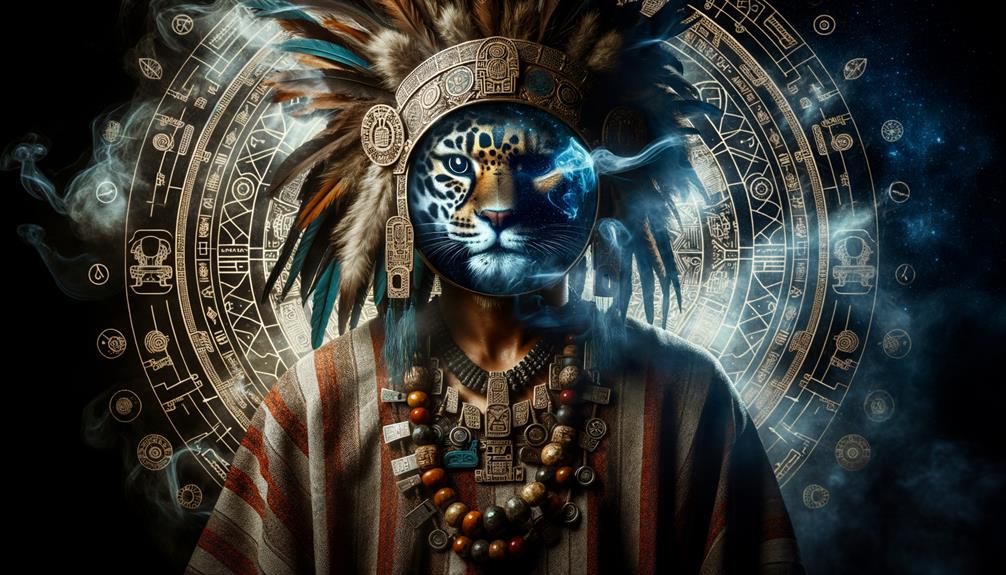Tezcatlipoca, the 'smoking mirror' of Aztec mythology, fascinates with his intricate persona comparable to tricksters like Loki or Hermes. His black and yellow face paint, jaguar symbolism – these visual cues reveal a multifaceted character. But the real intrigue stems from his sibling rivalry with Quetzalcoatl, mirroring the eternal clash between order and chaos. There's more to this shapeshifter's deceptions than meets the eye, inviting a deeper exploration.
Etymology and Names
Tezcatlipoca's name in Nahuatl, "smoking mirror," hints at his mystical association with obsidian mirrors. These weren't mere reflective surfaces but symbolic gateways granting divine insight beyond the spiritual realm – fitting for such an influential god.
His alternate titles underscore his omnipotence and multifaceted nature. "He Whose Slaves We Are" and "He by Whom We Live" portray him as a supreme ruler governing existence itself. As "Lord of the Near" and "Night and Wind," he paradoxically embodied both the ethereal and tangible.
This multiplicity of names reveals Tezcatlipoca's deep roots within Aztec society and complexity that rivaled his counterpart Quetzalcoatl. Allies at times, foes at others, their dynamic duality underscored the nuances of Aztec cosmology. Grasping the meaning behind Tezcatlipoca's epithets enriches our perspective on his pivotal place in Aztec mythology.
Iconography and Symbols
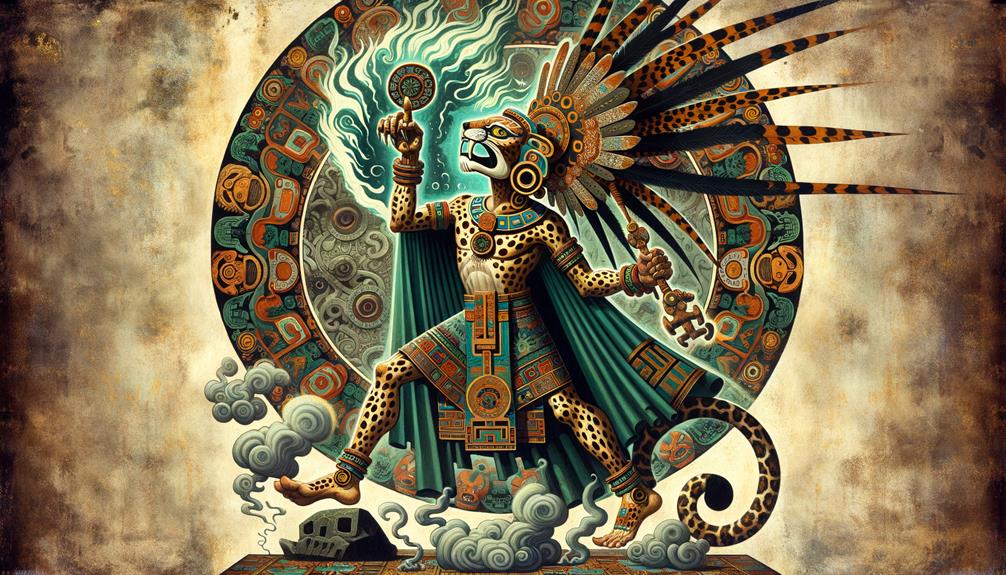
Tezcatlipoca's striking appearance, marked by black and yellow face paint, smoking mirrors, and jaguar motifs, perfectly captures his complex nature and profound influence in Aztec mythology. The contrasting hues adorning his face symbolize the duality at his core—light and darkness, life and death—reflecting his pivotal role in the Aztec belief system. The smoking mirror, often obsidian, represents his ability to peer into human souls, an embodiment of his all-seeing wisdom.
Priests donned elaborate feathered headdresses and intricate garments during sacred rituals, accentuating Tezcatlipoca's divine status. The black band beneath his eyes connects him to the night and underworld, reinforcing his association with the darker aspects of existence. Jaguars, another prominent motif, exemplify his strength and ferocity, tying into the creation myth where he played a central part.
| Symbol | Meaning |
|---|---|
| Black and Yellow Face Paint | Duality, light and dark |
| Smoking Mirror | Insight into human nature |
| Jaguar Imagery | Power, ferocity, night |
Tezcatlipoca's intricate iconography, layered with symbolic meaning, underscores his multifaceted nature as an Aztec deity, embodying power, mystery, and the cyclical nature of existence.
Myths and Legends
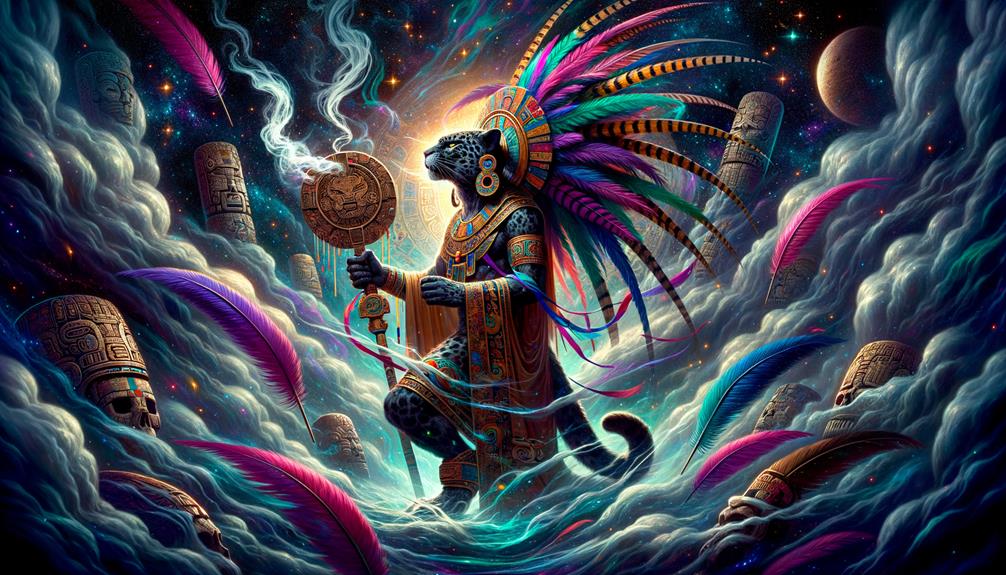
Stories about Tezcatlipoca's adventures reveal his sneaky and formidable presence in Aztec mythology. As a prominent Aztec deity, tales depict his complex sibling rivalry with his brother Quetzalcoatl, filled with cosmic conflicts shaping their world.
Tezcatlipoca's ability to shapeshift, especially into a powerful jaguar form, highlights his cunning and fluid nature. The jaguar symbolizes stealth and power, mirroring his influential role across different domains.
A well-known legend recounts Tezcatlipoca and Quetzalcoatl vying to create and destroy worlds, showcasing the gods' perpetual clashes. Tezcatlipoca often tricks and deceives, embodying the mischievous trickster archetype. While seemingly chaotic, his actions serve a greater cosmic purpose by reflecting creation and destruction's duality in Aztec mythology.
Rituals and Worship
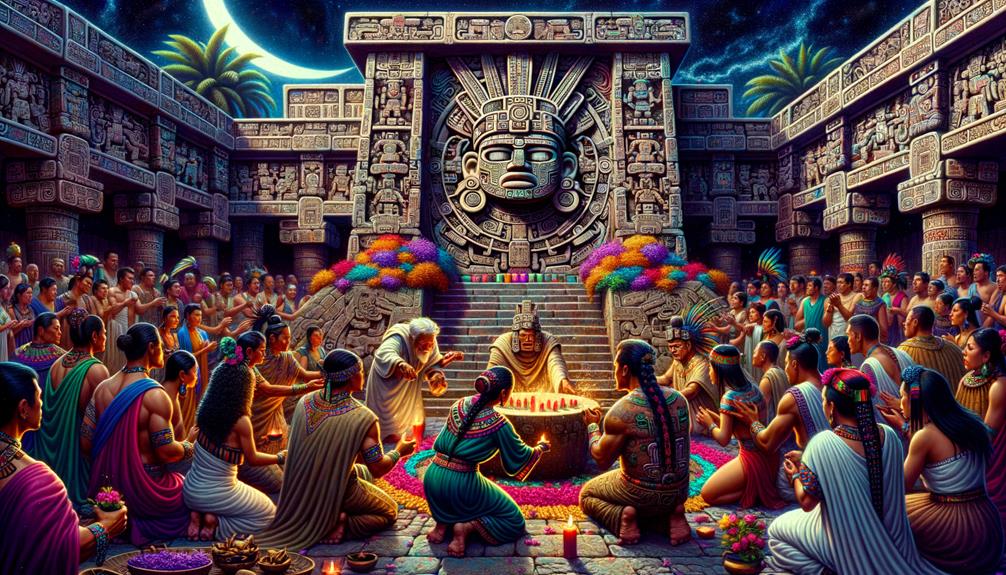
Through Aztec rituals, the reverence for the god Tezcatlipoca exemplified the deep connection between sacrifice and cosmic equilibrium. Tezcatlipoca, a pivotal deity in Aztec mythology, commanded both respect and offerings to preserve universal harmony. Intricate Aztec ceremonies often involved fasting, bloodletting, and human sacrifices – a practice rooted in maintaining the sun's journey and the world's continuity.
Priests, draped in black robes and masks, conducted these rites in temples and hallowed spaces, evoking sanctuaries for divine communion. Offerings of valuables and food adorned the rituals, symbolizing the community's devotion. Dance and music heightened the spiritual ambiance, fostering a palpable link between the deity and worshippers.
Divination played a pivotal role, with priests interpreting signs and omens to discern Tezcatlipoca's will, guiding actions and sacrifices. This underscored the belief that appeasing the god ensured survival. Through these rites, the Aztecs sought to maintain cosmic equilibrium and preserve an orderly realm.
Influence in Modern Culture
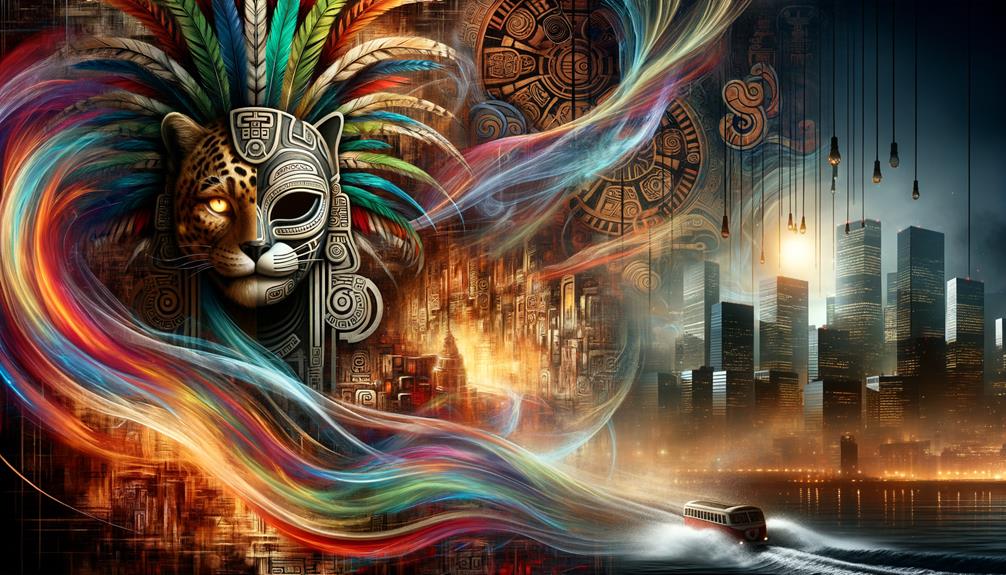
The mystique surrounding Tezcatlipoca in ancient Aztec rituals resonates profoundly in today's cultural landscape. This enigmatic deity's multifaceted persona continues inspiring creators across various mediums, from video games and manga to comics and music. Contemporary depictions often cast Tezcatlipoca as an antagonist, mirroring his mischievous and complex nature that enthralls modern audiences.
Tezcatlipoca's mythology effortlessly interweaves with contemporary narratives. Artists and storytellers draw from his rich lore, crafting compelling characters and tales that resonate with today's audiences. As a trickster god embodying both creation and destruction, order and chaos, Tezcatlipoca emerges as a versatile archetype. His duality mirrors the multifaceted human experience, making him a compelling subject for modern storytelling.
Frequently Asked Questions
Is Tezcatlipoca a Trickster God?
Tezcatlipoca embodied a mischievous spirit in Aztec mythology, aligning with trickster archetypes found across cultures. His penchant for deception and cunning influence over fate and creation set him apart, blurring the lines between good and evil. Unlike one-dimensional tricksters, Tezcatlipoca's complex nature defied easy categorization, reflecting the moral ambiguities of human existence. His mythological presence provoked contemplation on the paradoxical nature of the universe.
What Was Tezcatlipoca Worshiped For?
Tezcatlipoca's worship centered around his command over creation, fate and balance in the cosmos. His shape-shifting abilities and influence over destiny made him a focal point in rituals to seek prosperity, security and success. Embodying both light and dark, he shaped the universe's duality.
Who Is the Trickster God in Aztec Mythology?
In Aztec mythology, the trickster deity goes by Tezcatlipoca. This enigmatic figure represents duality, creation, and destruction – manipulating fate and morality through cunning transformations. Tezcatlipoca's mischievous persona aligns with trickster archetypes found across various mythological traditions. As a mysterious shapeshifter, he challenges conventional norms and boundaries, reflecting the complexities of the human experience.
How Powerful Is Tezcatlipoca?
Picture a powerful deity capable of influencing battlefields and determining civilizations' fates. Tezcatlipoca's dominance transcends limits, embodying both creation and destruction – a shape-shifting trickster bending reality itself.

